అబాకస్
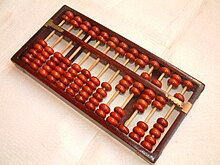
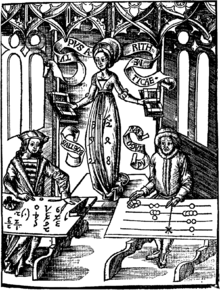

తెలుగు పేరు
[మార్చు]దీనిని తెలుగులో పూసలపాటీ అంటారు.
| “ | ఛార్లెస్ బబేజ్ కనుగొన్న అబాకస్ మూల ఆధారంగా, అంచలంచెలుగా లెక్కలు కట్టే సాధనాలు రూపొందించబడుతూ వచ్చి కాలక్రమేణా, నేటి ఎలక్ట్రానిక్ కాలిక్యులేటర్ల వేగం, వాడుక కూడా చాలా ఎక్కువైంది. ప్రస్తుత కాలంలో అబాకస్ ఒక పాతబడిపోయిన పురాతన వస్తువుగా కనిపిస్తుంది. అబాకస్ కు ఆధార సూత్రం, దాని తీగలకు అమర్చిన పూసల సంఖ్యలు. ఒక్కో తీగకు ఉన్న పూసల సంఖ్య, ఒక సంఖ్యలోని ఒక్కో స్థానానికి ప్రాతినిధ్యం వహిస్తుంది. సంఖ్యాశాస్త్రంలోని ప్రాధమిక విధానాలైన కూడిక, తీసివేత, గుణకారం, భాగహారం చేయడానికి ఉపయోగింపబడిన ప్రథమ సాధనం అబాకస్ | ” |
అబాకస్ అనునది కచ్చితంగా అంకగణిత సమస్యలను చేసే సాధనం. ఇది ఒక దీర్ఘచతురస్రాకార చట్రమును కలిగి దానిపై సమాంతరంగా కొన్ని తీగలను కలిగి ఉంటుంది. ఈ తీగలకు కొన్ని పూసలు గ్రుచ్చబడి ఉంటాయి. ఇవి కదులుతాయి. నవీన అబాకస్ యందు ఒక చెక్కతో చేయబడిన చట్రము నకు పూసలు గ్రుచ్చబడిన సమాంతర తీగలు కలిగి ఉంటాయి. దీనియందు ఒక అడ్డంగా ఉంచబడిన దండం లంబంగా ఉండి పూసలను రెండు వర్గాలుగా చేస్తుంది. నిలువుగా ఉన్న తీగలు స్థానవిలువలను, దశాంశ స్థానాలను తెలుపుతాయి. దీనిలో పూర్తిగా కుడివైపు గల నిలువు వరుస ఒకట్ల స్థానమును, దానికి ప్రక్క గల స్థానం పదుల స్థానమును యిలా స్థాన విలువలను తెలుపుతాయి. అబాకస్ ను అంక గణితంలో సంకలనం,వ్యవకలనం,గుణకారం, భాగహారం వంటి చతుర్విధ ప్రక్రియలను సులువుగా చేయచచ్చు. పూసల స్థానములను మార్చడం ద్వారా ఈ గణనలు చేయవచ్చు.
చరిత్ర
[మార్చు]మెసొపొటేమియా
[మార్చు]2700-2300 BC కాలంలో సుమేరియన్ అబాకస్ మొదటి ప్రదర్శనగా వెలువడినది. దీనిలో వరుస నిలువువరుసలలో షష్ట్యంశమాన సంఖ్య వ్యవస్థలో వరుస క్రమంలో పట్టిక ఉండేది.[1] కొంతమంది పండితులు బాబిలోనియన్ క్యూనిపోరం నుండి అబాకస్ లక్షణాలను సూచించవచ్చు.[2] ఇది పురాతన బాబిలోనియన్ యొక్క నమ్మకం.[3] బాబిలోనియన్లు Carruccio విద్వాంసులు నిర్వహణ కొరకు అదనంగా గణిత ప్రక్రియలైన కూడిక, తీసివేత చేయుటకు ఉపయోగించారు. అయితే ఈ పరికరం మరింత క్లిష్టమైన గణనలను కోసం ఉపయోగించడానికి కష్టసాధ్యం.
ఈజిప్టు
[మార్చు]పురాతన ఈజిప్ట్ లో అబాకస్ ను గ్రీకు చరిత్రకారుడు హెరిడోటస్ ఉపయోగించాడు.ఈయన ఈజిప్షియన్ గ్రంథాలలో గులకరాళ్లను కుడి నుండి ఎడమ పద్ధతిని గ్రీకుల ఎడమ నుండి కుడికి మార్చాడు. పురావస్తు శాస్త్రజ్ఞులు కౌంటర్లుగా ఉపయోగించునట్లు భావించే డిస్కులు కనుగొన్నారు. అయితే ఈ పరికరం యొక్క ఉనికిని సూచించుటలో అందేహం ఉంది.[4] లో అబాకస్ ఉపయోగం పురాతన ఈజిప్ట్ గ్రీకు చరిత్రకారుడు సూచించారు హెరోడోటస్ ఈజిప్షియన్లు గ్రీక్ ఎడమ కుడి పద్ధతి దిశలో సరసన, కుడి నుండి గులకరాళ్ళ అవకతవకలు ఆ వ్రాస్తాడు. పురావస్తు శాస్త్రజ్ఞులు కౌంటర్లు ఉపయోగిస్తారు భావిస్తున్నారు వివిధ పరిమాణాలు పురాతన డిస్కులు కనుగొన్నారు.
Persian
[మార్చు]During the Achaemenid Persian Empire, around 600 BC the Persians first began to use the abacus.[5] Under Parthian and Sassanian Iranian empires, scholars concentrated on exchanging knowledge and inventions by the countries around them – India, China, and the Roman Empire, when it is thought to be expanded over the other countries.
గ్రీక్
[మార్చు]గ్రీక్ అబాకస్ ఉపయోగం ప్రారంభ పురావస్తు ఆధారాలు 5 వ శతాబ్దం BC నాటిది.[6] గ్రీకు అబాకస్ చెక్క లేదా పాలరాయి యొక్క ఒక పట్టిక ఉంది, గణిత లెక్కల కోసం చెక్క లేదా లోహపు చిన్న కౌంటర్లు ముందు సెట్. ఈ గ్రీకు అబాకస్ ఫ్రెంచ్ విప్లవం, పాశ్చాత్య క్రైస్తవ ప్రపంచంలో వరకు, Achaemenid పర్షియా, ఎట్రుస్కాన్ నాగరికత, పురాతన రోమ్ లో ఉపయోగం చూసిన.
1846 AD (సలామీ టాబ్లెట్) లో గ్రీక్ ద్వీపం సలామీలో కనుగొనబడిన ఒక టాబ్లెట్, ఇప్పటివరకు కనుగొన్న ఇది పురాతన లెక్కింపు బోర్డు దీనితో తిరిగి 300 BC నాటిది. ఇది సెంమీ గుర్తులు 5 సమూహాలు ఇవి దట్టమైన దీర్ఘ (59), 75 సెంమీ (30) వెడల్పు, 4.5 సెంమీ (2 లో), తెల్ల పాలరాయితో 149 ఒక స్లాబ్. టాబ్లెట్ మధ్యలో దిగువన అత్యంత సమతల పంక్తి యొక్క ఖండన, వర్టికల్ లైన్ వద్ద ఒక అర్ధతో కప్పబడిన సమానంగా ఒక నిలువు గీత ద్వారా విభజించబడింది 5 సమాంతర రేఖలు సమితి. ఈ పంక్తులు క్రింద అది విభజించే ఒక సమాంతర క్రాక్ తో విస్తృత స్థలం. ఈ క్రాక్ పదకొండు సమాంతర రేఖలు మరొక సమూహం క్రింద, మళ్ళీ వాటిని లంబంగా లైన్ ద్వారా రెండు విభాగాలుగా విభజించబడింది, కానీ ఖండన ఎగువన అర్ధ తో; మూడవ, ఆరవ, ఈ పంక్తులు తొమ్మిదవ వారు నిలువు గీతతో కలిసే చోట ఒక క్రాస్ గుర్తించబడతాయి.
Roman
[మార్చు]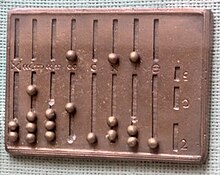
The normal method of calculation in ancient Rome, as in Greece, was by moving counters on a smooth table. Originally pebbles (calculi) were used. Later, and in medieval Europe, jetons were manufactured. Marked lines indicated units, fives, tens etc. as in the Roman numeral system. This system of 'counter casting' continued into the late Roman empire and in medieval Europe, and persisted in limited use into the nineteenth century.[7] Due to Pope Sylvester II's reintroduction of the abacus with very useful modifications, it became widely used in Europe once again during the 11th century[8]
Writing in the 1st century BC, Horace refers to the wax abacus, a board covered with a thin layer of black wax on which columns and figures were inscribed using a stylus.[9]
One example of archaeological evidence of the Roman abacus, shown here in reconstruction, dates to the 1st century AD. It has eight long grooves containing up to five beads in each and eight shorter grooves having either one or no beads in each. The groove marked I indicates units, X tens, and so on up to millions. The beads in the shorter grooves denote fives –five units, five tens etc., essentially in a bi-quinary coded decimal system, obviously related to the Roman numerals. The short grooves on the right may have been used for marking Roman ounces.
Chinese
[మార్చు]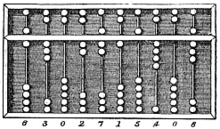
The earliest known written documentation of the Chinese abacus dates to the 2nd century BC.[10]
The Chinese abacus, known as the suànpán (算盤, lit. "Counting tray"), is typically 20 cమీ. (8 అం.) tall and comes in various widths depending on the operator. It usually has more than seven rods. There are two beads on each rod in the upper deck and five beads each in the bottom for both decimal and hexadecimal computation. The beads are usually rounded and made of a hardwood. The beads are counted by moving them up or down towards the beam. If you move them toward the beam, you count their value. If you move away, you don't count their value.[11] The suanpan can be reset to the starting position instantly by a quick jerk along the horizontal axis to spin all the beads away from the horizontal beam at the center.[12]
Suanpans can be used for functions other than counting. Unlike the simple counting board used in elementary schools, very efficient suanpan techniques have been developed to do multiplication, division, addition, subtraction, square root and cube root operations at high speed. There are currently schools teaching students how to use it.
In the famous long scroll Along the River During the Qingming Festival painted by Zhang Zeduan (1085–1145 AD) during the Song Dynasty (960–1297 AD), a suanpan is clearly seen lying beside an account book and doctor's prescriptions on the counter of an apothecary's (Feibao).
The similarity of the Roman abacus to the Chinese one suggests that one could have inspired the other, as there is some evidence of a trade relationship between the Roman Empire and China. However, no direct connection can be demonstrated, and the similarity of the abaci may be coincidental, both ultimately arising from counting with five fingers per hand. Where the Roman model (like most modern Japanese) has 4 plus 1 bead per decimal place, the standard suanpan has 5 plus 2, allowing use with a hexadecimal numeral system. Instead of running on wires as in the Chinese and Japanese models, the beads of Roman model run in grooves, presumably making arithmetic calculations much slower.
Another possible source of the suanpan is Chinese counting rods, which operated with a decimal system but lacked the concept of zero as a place holder. The zero was probably introduced to the Chinese in the Tang Dynasty (618-907 AD) when travel in the Indian Ocean and the Middle East would have provided direct contact with India, allowing them to acquire the concept of zero and the decimal point from Indian merchants and mathematicians.
Indian
[మార్చు]First century sources, such as the Abhidharmakosa describe the knowledge and use of abacus in India.[13] Around the 5th century, Indian clerks were already finding new ways of recording the contents of the Abacus.[14] Hindu texts used the term shunya (zero) to indicate the empty column on the abacus.[15]
Japanese
[మార్చు]
In Japanese, the abacus is called soroban (算盤, そろばん, lit. "Counting tray"), imported from China around 1600.[16] The 1/4 abacus, which is suited to decimal calculation, appeared circa 1930, and became widespread as the Japanese abandoned hexadecimal weight calculation which was still common in China. The abacus is still manufactured in Japan today even with the proliferation, practicality, and affordability of pocket electronic calculators. The use of the soroban is still taught in Japanese primary schools as part of mathematics, primarily as an aid to faster mental calculation. Using visual imagery of a soroban, one can arrive at the answer in the same time as, or even faster than, is possible with a physical instrument.[17]
Korean
[మార్చు]The Chinese abacus migrated from China to Korea around 1400 AD.[18] Koreans call it jupan (주판), supan (수판) or jusan (주산).[19]
Native American
[మార్చు]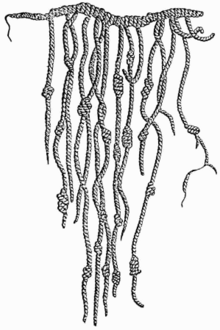

Some sources mention the use of an abacus called a nepohualtzintzin in ancient Mayan culture. This Mesoamerican abacus used a 5-digit base-20 system.[20] The word Nepōhualtzintzin మూస:IPA-nah comes from the Nahuatl and it is formed by the roots; Ne - personal -; pōhual or pōhualli మూస:IPA-nah - the account -; and tzintzin మూస:IPA-nah - small similar elements. And its complete meaning was taken as: counting with small similar elements by somebody. Its use was taught in the Calmecac మూస:IPA-nah to the temalpouhqueh మూస:IPA-nah, who were students dedicated to take the accounts of skies, from childhood. Unfortunately the Nepōhualtzintzin and its teaching were among the victims of the conquering destruction, when a diabolic origin was attributed to them after observing the tremendous properties of representation, precision and speed of calculations.[ఆధారం చూపాలి]
This arithmetic tool was based on the vigesimal system (base 20).[21] For the Aztec the count by 20s was completely natural. The amount of 4, 5, 13, 20 and other cyclees meant cycles.[విడమరచి రాయాలి] The Nepōhualtzintzin was divided in two main parts separated by a bar or intermediate cord. In the left part there were four beads, which in the first row have unitary values (1, 2, 3, and 4), and in the right side there are three beads with values of 5, 10, and 15 respectively. In order to know the value of the respective beads of the upper rows, it is enough to multiply by 20 (by each row), the value of the corresponding account in the first row.
Altogether, there were 13 rows with 7 beads in each one, which made up 91 beads in each Nepōhualtzintzin. This was a basic number to understand, 7 times 13, a close relation conceived between natural phenomena, the underworld and the cycles of the heavens. One Nepōhualtzintzin (91) represented the number of days that a season of the year lasts, two Nepōhualtzitzin (182) is the number of days of the corn's cycle, from its sowing to its harvest, three Nepōhualtzintzin (273) is the number of days of a baby's gestation, and four Nepōhualtzintzin (364) completed a cycle and approximate a year (1¼ days short). The Nepōhualtzintzin amounted to the rank from 10 to the 18 in floating point, which calculated stellar as well as infinitesimal amounts with absolute precision, meant that no round off was allowed, when translated into modern computer arithmetic.
The rediscovery of the Nepōhualtzintzin was due to the Mexican engineer David Esparza Hidalgo,[22] who in his wanderings throughout Mexico found diverse engravings and paintings of this instrument and reconstructed several of them made in gold, jade, encrustations of shell, etc. [ఆధారం చూపాలి]. There have also been found very old Nepōhualtzintzin attributed to the Olmeca culture, and even some bracelets of Mayan origin, as well as a diversity of forms and materials in other cultures.
George I. Sanchez, "Arithmetic in Maya", Austin-Texas, 1961 found another base 5, base 4 abacus in the Yucatán that also computed calendar data. This was a finger abacus, on one hand 0 1,2, 3, and 4 were used; and on the other hand used 0, 1, 2 and 3 were used. Note the use of zero at the beginning and end of the two cycles. Sanchez worked with Sylvanus Morley, a noted Mayanist.
The quipu of the Incas was a system of knotted cords used to record numerical data, like advanced tally sticks – but not used to perform calculations. Calculations were carried out using a yupana (Quechua for "counting tool"; see figure) which was still in use after the conquest of Peru. The working principle of a yupana is unknown, but in 2001 an explanation of the mathematical basis of these instruments was proposed by Italian mathematician Nicolino De Pasquale. By comparing the form of several yupanas, researchers found that calculations were based using the Fibonacci sequence 1, 1, 2, 3, 5 and powers of 10, 20 and 40 as place values for the different fields in the instrument. Using the Fibonacci sequence would keep the number of grains within any one field at minimum.[23]
Russian
[మార్చు]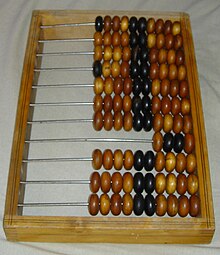
The Russian abacus, the schoty (счёты), usually has a single slanted deck, with ten beads on each wire (except one wire, usually positioned near the user, with four beads for quarter-ruble fractions). Older models have another 4-bead wire for quarter-kopeks, which were minted until 1916. The Russian abacus is often used vertically, with wires from left to right in the manner of a book. The wires are usually bowed to bulge upward in the center, to keep the beads pinned to either of the two sides. It is cleared when all the beads are moved to the right. During manipulation, beads are moved to the left. For easy viewing, the middle 2 beads on each wire (the 5th and 6th bead) usually are of a different colour from the other eight beads. Likewise, the left bead of the thousands wire (and the million wire, if present) may have a different color.
As a simple, cheap and reliable device, the Russian abacus was in use in all shops and markets throughout the former Soviet Union, and the usage of it was taught in most schools until the 1990s.[24][25] Even the 1874 invention of mechanical calculator, Odhner arithmometer, had not replaced them in Russia and likewise the mass production of Felix arithmometers since 1924 did not significantly reduce their use in the Soviet Union.[26] Russian abacus began to lose popularity only after the mass production of microcalculators had started in the Soviet Union in 1974. Today it is regarded as an archaism and replaced by the handheld calculator.
The Russian abacus was brought to France around 1820 by the mathematician Jean-Victor Poncelet, who served in Napoleon's army and had been a prisoner of war in Russia.[27] The abacus had fallen out of use in western Europe in the 16th century with the rise of decimal notation and algorismic methods. To Poncelet's French contemporaries, it was something new. Poncelet used it, not for any applied purpose, but as a teaching and demonstration aid.[28]
School abacus
[మార్చు]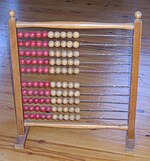
Around the world, abaci have been used in pre-schools and elementary schools as an aid in teaching the numeral system and arithmetic.
In Western countries, a bead frame similar to the Russian abacus but with straight wires and a vertical frame has been common (see image). It is still often seen as a plastic or wooden toy.
The type of abacus shown here is often used to represent numbers without the use of place value. Each bead and each wire has the same value and used in this way it can represent numbers up to 100.
Renaissance abaci gallery
[మార్చు]Uses by the blind
[మార్చు]An adapted abacus, invented by Tim Cranmer, called a Cranmer abacus is still commonly used by individuals who are blind. A piece of soft fabric or rubber is placed behind the beads so that they do not move inadvertently. This keeps the beads in place while the users feel or manipulate them. They use an abacus to perform the mathematical functions multiplication, division, addition, subtraction, square root and cubic root.[29]
Although blind students have benefited from talking calculators, the abacus is still very often taught to these students in early grades, both in public schools and state schools for the blind. The abacus teaches mathematical skills that can never be replaced with talking calculators and is an important learning tool for blind students.[ఆధారం చూపాలి] Blind students also complete mathematical assignments using a braille-writer and Nemeth code (a type of braille code for mathematics) but large multiplication and long division problems can be long and difficult. The abacus gives blind and visually impaired students a tool to compute mathematical problems that equals the speed and mathematical knowledge required by their sighted peers using pencil and paper. Many blind people find this number machine a very useful tool throughout life.[29]
Binary abacus
[మార్చు]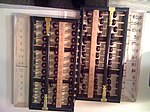
The binary abacus is used to explain how computers manipulate numbers.[30] The abacus shows how numbers, letters, and signs can be stored in a binary system on a computer, or via ASCII. The device consists of a series of beads on parallel wires arranged in three separate rows. The beads represent a switch on the computer in either an 'on' or 'off' position.
See also
[మార్చు]Notes
[మార్చు]- ↑ Ifrah 2001:11
- ↑ Crump 1992:188
- ↑ "Chronology of Mesopotamian Mathematics". It.stlawu.edu. 2001-05-30. Archived from the original on 2019-01-25. Retrieved 2012-06-06.
- ↑ Smith 1958:157–160
- ↑ "West Asian Mathematics". History for Kids!. Archived from the original on 2015-09-10. Retrieved 2012-06-06.
- ↑ Ifrah 2001:15
- ↑ Pullan, page18
- ↑ Nancy Marie Brown, "The Abacus and the Cross: The Story of the Pope Who Brought the Light of Science to the Dark Ages"; see a presentation at http://www.religiondispatches.org/books/rd10q/3878/everything_you_think_you_know_about_the_dark_ages_is_wrong/ Archived 2014-08-08 at the Wayback Machine
- ↑ Ifrah 2001:18
- ↑ Ifrah 2001:17
- ↑ Fernandes, Luis (November 27, 2003), "A Brief Introduction to the Abacus", ee.ryerson.ca, archived from the original on 2014-12-26, retrieved 2009-10-24
- ↑ "Chinese abacus." Popular Science, August 1948, pp. 87–89.
- ↑ Stearns & Langer 2001:44
- ↑ Körner & Langer 1996:232
- ↑ Mollin 1998:3
- ↑ Fernandes, Luis, The Abacus: A Brief History
- ↑ "Ancient calculator is a hit with Japan's newest generation / The Christian Science Monitor". CSMonitor.com. 1982-07-20. Retrieved 2012-06-06.
- ↑ "Abacusmiddle ages, region of origin Middle East". Thocp.net. 2002-09-12. Archived from the original on 2014-05-09. Retrieved 2012-06-06.
- ↑ "주판 : Daum 백과사전" (in Korean). Enc.daum.net. Retrieved 2012-06-06.
{{cite web}}: CS1 maint: unrecognized language (link) - ↑ Nepohualtzintzin Archived 2015-05-03 at the Wayback Machine The Pre Hispanic Computer
- ↑ "MesoAmerican Abacus". Tux.org. Archived from the original on 2008-09-07. Retrieved 2012-06-06.
- ↑ David Esparza Hidalgo, Nepohualtzintzin. Computador Prehispanico en Vigencia [The Nepohualtzintzin: a pre-Hispanic computer in use] (Mexico City, Mexico: Editorial Diana, 1977).
- ↑ Andean Calculators Archived 2015-05-03 at the Wayback Machine, Antonio Aimi, Nicolino De Pasquale (translated by Franca Del Bianco)
- ↑ Robert Bud, Deborah Jean Warner (eds.), Instruments of science: an historical encyclopedia, p7, Taylor & Francis, 1998 ISBN 0-8153-1561-9.
- ↑ Sharon Hudgins, The Other Side of Russia, p219, Texas A&M University Press, 2004 ISBN 1-58544-404-9.
- ↑ A. M. Leushina, The development of elementary mathematical concepts in preschool children, p427, National Council of Teachers of Mathematics, 1991 ISBN 0-87353-299-6
- ↑ Georg Trogemann, Alexander Y. Nitussov, Wolfgang Ernst, Computing in Russia: The History of Computer Devices and Information Technology Revealed, p24, Vieweg+Teubner Verlag, 2001 ISBN 3-528-05757-2.
- ↑ Graham Flegg, Numbers: Their History and Meaning, p72, Courier Dover Publications, 2002 ISBN 0-486-42165-1.
- ↑ 29.0 29.1 Terlau, Terrie; Gissoni, Fred (July 20, 2006), Abacus: Position Paper, APH.org, archived from the original on 2014-08-01, retrieved 2009-10-23
- ↑ Robert C. Good, Jr., "The binary abacus: a useful tool for explaining computer operations", Journal of Computers in Mathematics and Science Teaching, vol.5, Iss.1 (Fall 1985), pp.34-37.
మూలాలు
[మార్చు]- Carruccio, Ettore (2006), Mathematics And Logic in History And in Contemporary Thought, Aldine Transaction, ISBN 0-202-30850-2.
- Crump, Thomas (1992), The Japanese Numbers Game: The Use and Understanding of Numbers in Modern Japan, Routledge, ISBN 0-415-05609-8.
- Ifrah, Georges (2001), The Universal History of Computing: From the Abacus to the Quantum Computer, New York: John Wiley & Sons, ISBN 0-471-39671-0.
- Körner, Thomas William; Langer, William Leonard (1996), The Pleasures of Counting, Houghton Mifflin Books, ISBN 0-521-56823-4.
- Mollin, Richard Anthony (1998), Fundamental Number Theory with Applications, CRC Press, ISBN 0-8493-3987-1.
- Peng Yoke Ho (2000), Li, Qi and Shu: An Introduction to Science and Civilization in China, Courier Dover Publications, ISBN 0-486-41445-0.
- Pullan, J. M. (1968), The History of the Abacus, London: Books That Matter, ISBN 0-09-089410-3.
- Reilly, Edwin D.; Langer, William Leonard (2004), Concise Encyclopedia of Computer Science, John Wiley and Sons, ISBN 0-470-09095-2.
- Smith, David Eugene (1958), History of Mathematics (Volume 2), Courier Dover Publications, ISBN 0-486-20430-8.
- Stearns, Peter N.; Langer, William Leonard (2001), The Encyclopedia of World History: Ancient, Medieval, and Modern, Chronologically Arranged, Houghton Mifflin Books, ISBN 0-395-65237-5.
- Mish, Frederick C., ed. (2003), Merriam-Webster's Collegiate Dictionary (11th ed.), Merriam-Webster, Inc, ISBN 0-87779-809-5.
- మూస:OED
Further reading
[మార్చు]- Menninger, Karl W. (1969), Number Words and Number Symbols: A Cultural History of Numbers, MIT Press, ISBN 0-262-13040-8.
- Kojima, Takashi (1954), The Japanese Abacus: its Use and Theory, Tokyo: Charles E. Tuttle, ISBN 0-8048-0278-5.
- Stephenson, Stephen K. (July 7, 2010), Ancient Computers, IEEE Global History Network, retrieved 2011-07-02
- Stephenson, Stephen K. (2011), Ancient Computers, Part I - Rediscovery, Amazon.com, ASIN B004RH3J7S.
యితర లింకులు
[మార్చు]![]() Media related to Abacus at Wikimedia Commons
Media related to Abacus at Wikimedia Commons
 Texts on Wikisource:
Texts on Wikisource:
- Chisholm, Hugh, ed. (1911). "Abacus". ఎన్సైక్లోపీడియా బ్రిటానికా (in ఇంగ్లీష్) (11th ed.). Cambridge University Press.
- “Abacus,” from A Dictionary of Greek and Roman Antiquities, 3rd ed., 1890.
Tutorials
[మార్చు]- Min Multimedia
- Heffelfinger, Totton & Gary Flom, Abacus: Mystery of the Bead - an Abacus Manual, archived from the original on 2013-06-24, retrieved 2013-07-10
Abacus curiosities
[మార్చు]- CS1 maint: unrecognized language
- ISBN మ్యాజిక్ లింకులను వాడే పేజీలు
- Articles with hatnote templates targeting a nonexistent page
- Articles containing Japanese-language text
- మూలాలు చేర్చవలసిన పాఠ్యమున్న వ్యాసాలు
- మూలాలు చేర్చవలసిన పాఠ్యమున్న వ్యాసాలు from November 2009
- Wikipedia articles needing clarification from January 2011
- మూలాలు చేర్చవలసిన పాఠ్యమున్న వ్యాసాలు from January 2013
- Roman mathematics
- Abacus
- Mathematical tools
- Chinese mathematics
- Indian mathematics
- Greek mathematics
- Japanese mathematics
- Egyptian mathematics
- గణిత శాస్త్రము
- పరికరాలు









